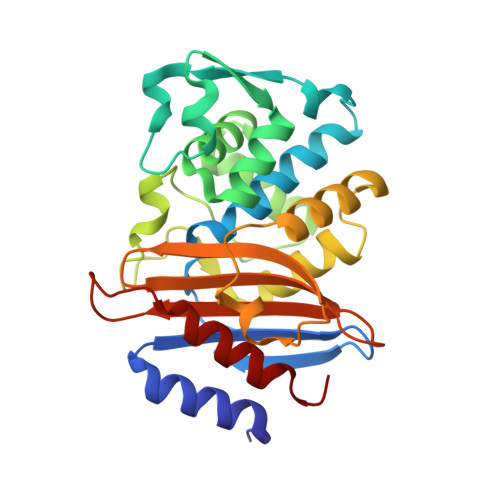Molecular Basis for the Catalytic Specificity of the CTX-M Extended-Spectrum beta-Lactamases.
Adamski, C.J., Cardenas, A.M., Brown, N.G., Horton, L.B., Sankaran, B., Prasad, B.V., Gilbert, H.F., Palzkill, T.(2015) Biochemistry 54: 447-457
- PubMed: 25489790
- DOI: https://doi.org/10.1021/bi501195g
- Primary Citation of Related Structures:
4PM5, 4PM6, 4PM7, 4PM8, 4PM9, 4PMA - PubMed Abstract:
Extended-spectrum ¦Ā-lactamases (ESBLs) pose a threat to public health because of their ability to confer resistance to extended-spectrum cephalosporins such as cefotaxime. The CTX-M ¦Ā-lactamases are the most widespread ESBL enzymes among antibiotic resistant bacteria. Many of the active site residues are conserved between the CTX-M family and non-ESBL ¦Ā-lactamases such as TEM-1, but the residues Ser237 and Arg276 are specific to the CTX-M family, suggesting that they may help to define the increased specificity for cefotaxime hydrolysis. To test this hypothesis, site-directed mutagenesis of these positions was performed in the CTX-M-14 ¦Ā-lactamase. Substitutions of Ser237 and Arg276 with their TEM-1 counterparts, Ala237 and Asn276, had a modest effect on cefotaxime hydrolysis, as did removal of the Arg276 side chain in an R276A mutant. The S237A:R276N and S237A:R276A double mutants, however, exhibited 29- and 14-fold losses in catalytic efficiency for cefotaxime hydrolysis, respectively, while the catalytic efficiency for benzylpenicillin hydrolysis was unchanged. Therefore, together, the Ser237 and Arg276 residues are important contributors to the cefotaximase substrate profile of the enzyme. High-resolution crystal structures of the CTX-M-14 S70G, S70G:S237A, and S70G:S237A:R276A variants alone and in complex with cefotaxime show that residues Ser237 and Arg276 in the wild-type enzyme promote the expansion of the active site to accommodate cefotaxime and favor a conformation of cefotaxime that allows optimal contacts between the enzyme and substrate. The conservation of these residues, linked to their effects on structure and catalysis, imply that their coevolution is an important specificity determinant in the CTX-M family.
Organizational Affiliation:
Verna and Marrs McLean Department of Biochemistry and Molecular Biology, ?Department of Molecular Virology and Microbiology, ”ĪDepartment of Pharmacology, Baylor College of Medicine , One Baylor Plaza, Houston, Texas 77030, United States.

















